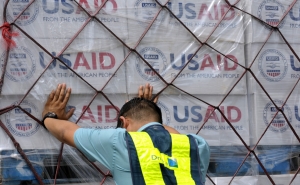Why the Health of Indigenous People Impacts Us All
Indigenous communities possess strengths, knowledge, and traditions that can benefit everyone.

Indigenous people around the world face striking health disparities, including higher rates of diabetes, malnutrition, and tuberculosis. In the U.S., they also experience higher rates of illnesses ranging from flu and pneumonia to heart disease and stroke—and, not surprisingly, have shorter life expectancies than their white counterparts.
Yet these disparities belie the strength and resilience of Indigenous communities. And leveraging Indigenous culture, traditions, beliefs, and knowledge has the potential to address not just health issues, but broader environmental problems that affect the health of all populations, says Donald Warne, MD, MPH.
In this Q&A, adapted from the October 10 episode of Public Health On Call, Warne, the new co-director of the Johns Hopkins Center for Indigenous Health and a member of the Oglala Lakota tribe, talks with Josh Sharfstein about the challenges and opportunities for the health of the world’s Indigenous populations. They also discuss the expansive work of the Center, and the hope that greater understanding of Indigenous health will bring a broad range of benefits to the world.
Can you tell us a little about your incredible career?
I’ve been working in various aspects of health care for my whole career. After I finished medical school at Stanford in 1995, I did a family medicine residency and then worked for a number of years as a primary care doctor with Indian Health Service and the tribal programs. I found that so many things we were dealing with in the clinic were preventable. We’re not going to prevent things like diabetes in the hospital—that really has to be done in the community. That’s when I switched my career toward public health.
I was fortunate to do the Commonwealth Fund Fellowship in Minority Health Policy and get my Master of Public Health at Harvard University in 2002. Over the last 20 years, my career has been focused on trying to improve Indigenous health through community-based research and program development designed to promote health and prevent disease in Indigenous populations.
Can you give examples of the kinds of programs you’ve worked on?
I did work on the Diabetes Prevention Program (the DPP) a multicenter study that was started in the late ’90s and went through the early 2000s. Through the National Institutes of Health, I was a staff clinician with the National Institute of Diabetes and Digestive and Kidney Diseases, which has a Phoenix epidemiology and clinical research branch. Out of that office, we conducted the DPP in several tribal sites, including Shiprock, New Mexico; Zuni, Pueblo, Gila River Indian Community, and Salt River Pima-Maricopa Indian Community in Arizona; as well as the Phoenix Indian Medical Center.
One of the wonderful outcomes is that we were able to show very clearly that the best way to prevent diabetes is through appropriate lifestyle intervention. It’s even more effective than using diabetes medications. From a public health perspective, it’s wonderful to see that these things that we had been encouraging people to do over the years could be borne out scientifically in the research process.
What that tells us is that we need programs and policies that make accessing healthier food much easier; we need to make the healthy choice the easier choice. Unfortunately, in many tribal communities and other underserved populations, quite often the healthier foods are more expensive, and people are priced out of making healthier choices even when they want to. There’s been a whole area of work looking at food access and making sure we’re promoting health through appropriate policies and program development.
When you’re doing a study like that, do you have to adapt interventions for the environment and culture of the groups that you’re working with?
In an ideal setting, we’re adapting evidence-based practices. That’s been a struggle with a lot of the funding agencies and working with national programs through CDC, SAMSA, or other federal programs. They want us to use evidence-based practices, which makes a lot of sense, but my question is always: whose evidence is it? If something works effectively in Baltimore, that doesn’t necessarily mean it’s going to work effectively in Kyle, South Dakota. We also have to take the local assets and resources into account. If we’re making diet and exercise recommendations, we have to make sure that we have access to those things in the communities.
As an example, when I was a clinician, I also became a certified diabetes educator. Looking at special populations with diabetes, for example, those with arthritis, they were making recommendations for water aerobics and swimming. That’s wonderful if you have access to a swimming pool, but on our reservation communities, we don’t. So we can’t just assume that a program that works in a city or a suburb can just be plopped into a reservation or other underserved population and be effective. We have to be flexible in public health practice and leverage the local assets and resources to modify evidence-based practices appropriately.
There are also structural impediments to good health that affect a lot of tribal communities. How do you address that in your work in Indigenous health?
We do have a lot of impediments and challenges. Certainly poverty is one of them. Many of our tribal communities are very rural and isolated, without local access to many things that we might take for granted when we live in a city.
But on the strengths-based side is the resilience of our communities. We also have other unique strengths—for example, cultural connectedness, participation, traditional ceremony, and even language preservation have all been shown to be effective ways to promote health and are protective against negative outcomes of some social determinants of health. So in addition to addressing those impediments and challenges, we need to be leveraging the strengths. What I’d love to see coming out of our Center is much more broad-based research and interventions that really leverage the strengths of Indigenous populations.
You have come to Johns Hopkins as the Center for American Indian Health is being renamed the Center for Indigenous Health. What do you hope this field can accomplish?
First, I’d really like to acknowledge the long-standing history of the Center for American Indian Health, which has been in place since the early 1990s, and the work Dr. Mathu Santosham did with several tribes in Arizona.
Over the last 30 years, the field has really evolved, and we’re seeing some significant similarities across Indigenous peoples worldwide. As an example, in 2003 I was presenting at the International Diabetes Federation in Melbourne, Australia. I was on an Indigenous diabetes panel, along with a speaker from Australia and a speaker from New Zealand. We’re all Indigenous academics—and we didn’t coordinate ahead of time—but we each gave essentially the same presentation with the same data, even though it was from different populations in different parts of the world with different histories. The impact of colonization really is ubiquitous. It has an impact on things like marginalization, cultural connectedness, loss of food, sovereignty, and loss of traditional lifestyles.
When we think about the work that needs to be done from here, of course we cannot reverse history, but we can try to create a better future for Indigenous populations. There’s so much work to be done in terms of identifying the strengths that can be and should be leveraged, and how we might work within our very diverse health systems internationally to promote health and prevent disease for Indigenous people. Moving forward, I’m very excited about the work that we can do with our international colleagues.
I understand that will be a focus now of the Center’s work to create new opportunities for insights and collaboration to promote Indigenous health here in the U.S.
One thing we’re discussing is developing an Indigenous health database. We have some databases like the Behavioral Risk Factor Surveillance System (BRFSS), but we historically have had limited participation from American Indian populations in that database. I would love to see a database that includes the types of questions on the BRFSS but also questions more focused on Indigenous populations, like measures of historical trauma, family or personal experiences with forced boarding school participation, and things like adverse childhood experiences, but also, on the strengths side, measures of language preservation, cultural connectedness, or participation in ceremonies. This would allow us to make more meaningful correlations within the data to understand the risk factors for our people, as well as the strengths we can leverage to improve outcomes.
As you look forward to the work that you do, what do you want people to understand about Indigenous health? What can work better in the future?
Indigenous peoples are the original inhabitants of various parts of the earth. Here in the U.S. the American Indian-Alaskan Native population are the Indigenous North Americans, and we can’t forget about Native Hawaiians as being the Indigenous peoples of Hawaii. Indigenous peoples have a deep-rooted sense of connectivity to place and the sacredness of place, and a deep-rooted cultural and spiritual connectedness to the earth and the natural environment.
Promoting Indigenous health and reviving those strengths of culture that integrate the natural world with health can benefit all populations, not just Indigenous peoples. When we look at some of the challenges we’re facing right now with climate change and environmental degradation, and outcomes like hurricanes, fires, floods, and droughts, I believe that the solutions to some of these challenges will come from Indigenous belief systems and practices. I see this as being of benefit to Indigenous peoples—and to all people.
Joshua Sharfstein, MD, is the vice dean for Public Health Practice and Community Engagement and a professor in Health Policy and Management at the Johns Hopkins Bloomberg School of Public Health. He is also the director of the Bloomberg American Health Initiative and a host of the Public Health On Call podcast.





